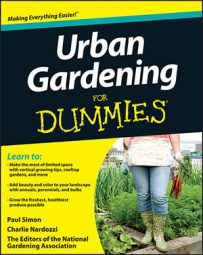Worms are amazing decomposers and will produce excellent fertilizer important for urban farming. They’re voracious vegetarians, eating materials such as vegetable kitchen scraps, fruit peels, shredded black and white paper, pulverized eggshells, and coffee grounds. In fact, they eat their weight in kitchen scraps every day! Okay, so they aren’t exactly chubby, but that’s still impressive.
You can raise worms in bins in a closet, under the kitchen sink, in a basement — really anywhere they won’t freeze and you can keep an eye on them. The payoff of raising worms is rich compost that’s perfect for young seedlings, vegetables, houseplants, herbs, and just about any other plant. It’s odorless and has a good balance of nutrients, and soil microbes love to eat it.
Worm composting is perfect for the urban dweller with limited space and lots of kitchen scraps and curiosity. Plus, kids love raising worms in the house. Don’t worry! They won’t escape and end up in the bedroom. They’ll stay in the bin where the food is.
If you want to give worm composting a try, follow these steps to set up your worm bin:
Get a bin.
You can raise worms in almost any sealed container, including an empty plastic soda bottle or a store-bought plastic or rubber storage box. But the easiest way is to purchase a commercial worm bin. Commercial bins are the right size to fit under sinks and in small spaces, have the proper drainage holes, and include a lid to keep the worms’ environment dark.
If you make your own bin, drill 8 to 15 holes in the bottom for proper water drainage and place a tray to catch the water underneath it.
![[Credit: Illustration by Kathryn Born.]](https://www.dummies.com/wp-content/uploads/369975.image0.jpg) Credit: Illustration by Kathryn Born.
Credit: Illustration by Kathryn Born.Fill the bin three-quarters full with bedding material.
Moistened and shredded black-and-white newspaper is best. Add a handful of potting soil to help the worms digest the food scraps you’ll hide in the newspaper. Fluff up the bedding so it’s not matted.
Get some worms.
Indoor worm bins need special worms. Don’t go digging up night crawlers from your yard and expect them to work. The worm of choice for bins is the red wiggler. Red wigglers are adapted to indoor temperatures and environments. One pound of worms can process 3 to 4 pounds of food scraps per week. Most kitchens can get started by purchasing 2 pounds of worms for their bin.
Feed your worms by tucking food scraps in the bedding in different sections of the bin.
Worms like it dark and will go about finding the food and digesting it. They eat a variety of vegetarian specialties, including vegetable and fruit scraps, pulverized eggshells, coffee grounds, and tea bags.
Avoid feeding them meats, dairy products, and oily foods, which can create foul odors or attract flies or rodents. Don’t overfeed them; use 3 to 4 pounds of food scraps per week for a normal-sized bin (roughly 2 feet square and 8 inches deep).
After about 2 to 3 months, when the bin is mostly worm poop (called castings), it’s time to harvest the compost. The easiest way is to push all the castings to one side of the bin and put fresh bedding in the other side. Give the worms a few days to migrate to the new food and then scoop out the finished worm manure.
For more information on raising worms indoors, check out Worms Eat My Garbage by Mary Appelhof (Flower Press).
Although using the worm castings straight from the worm bin is fine, you can make the rich compost go farther by making worm tea. Simply place two cups of worm castings in cheesecloth or old pantyhose. Suspend the worm castings in a bucket of water for 24 hours, stirring occasionally.
The water will turn brown from all the nutrients and microbes that leach into the water from the worm castings. Use the nutrient-rich water on plants within a few days and dump the worm castings in the garden.

